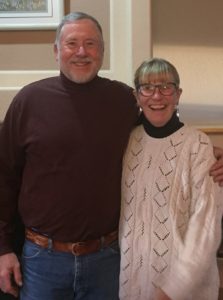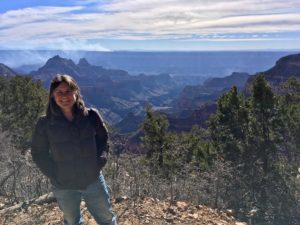“The Puma Years” with Laura Coleman
 In her early twenties, Laura Coleman finds herself living in London, her life an endless loop of commuting and corporate meetings. Tired of tight tailored suits and lacking direction, she quits her job and sets out for South America. Two months into her three-month trip to Bolivia, Laura is tired, bloated, sunburnt, lonely, and ready to go home. But a flyer about an animal welfare charity encourages her to stick it out, and soon she is en route to “el parque” in the heart of the Amazon. Arriving at el parque, Laura finds an underfunded, understaffed, dilapidated camp, along with suicidal howler monkeys, megalomaniac pigs, toothless jaguars, and many more animals who had been abused and abandoned. She also meets a timid and moody puma named Wayra who she now has to learn how to “walk” outside of her enclosure. Within days, all Laura can think about is going home. But after several weeks of barely showering, being eaten alive by bugs, and doing work that pushes her to a physical and emotional exhaustion she’s never known, Laura deliberately misses her flight back to England and spends the next two years learning how to trust Wayra, as well as how to trust herself.
In her early twenties, Laura Coleman finds herself living in London, her life an endless loop of commuting and corporate meetings. Tired of tight tailored suits and lacking direction, she quits her job and sets out for South America. Two months into her three-month trip to Bolivia, Laura is tired, bloated, sunburnt, lonely, and ready to go home. But a flyer about an animal welfare charity encourages her to stick it out, and soon she is en route to “el parque” in the heart of the Amazon. Arriving at el parque, Laura finds an underfunded, understaffed, dilapidated camp, along with suicidal howler monkeys, megalomaniac pigs, toothless jaguars, and many more animals who had been abused and abandoned. She also meets a timid and moody puma named Wayra who she now has to learn how to “walk” outside of her enclosure. Within days, all Laura can think about is going home. But after several weeks of barely showering, being eaten alive by bugs, and doing work that pushes her to a physical and emotional exhaustion she’s never known, Laura deliberately misses her flight back to England and spends the next two years learning how to trust Wayra, as well as how to trust herself.
Set against a backdrop of deforestation, illegal animal trade, and forest fires, THE PUMA YEARS: A Memoir explores what happens when two desperate creatures in need of rescue find one another. Laura lures the reader into the center of the Bolivian jungle with her exquisite descriptions of the vivid colors, insects, animals, trees, plants, dirt, and swamps that she encounters daily. The emotional highs and lows are real and raw. The relationships – with both animals and humans – are complicated, but intimate. And we fall in love with all of el parque’s residents. As that three-month ticket to Bolivia slowly turns into her life mission, Laura finds her passion and herself through helping endangered animals. Readers watch with tenderness and awe as Laura blossoms into a courageous leader, having started as an unwitting volunteer and growing to become el parque’s fiercest supporter. In this truly immersive and moving memoir, Laura explores the unique love that exists between humans and animals. Earnest, yet humorous in tone, this book is for anyone who is seeking self-discovery, a sense of belonging, unconditional love, or a greater purpose.
About Laura Coleman
 Laura Coleman (she/her) is a writer and an artist. She has lived and worked in Bolivia for over a decade, caring for rescued wild animals with the NGO Comunidad Inti Wara Yassi. This is the subject of her first book, a memoir, entitled THE PUMA YEARS. She is also the founder of ONCA, a Brighton (UK) based arts charity that bridges social and environmental justice issues with creativity, and she lives by the sea on the Isle of Eigg in Scotland with a dog called Nelo.
Laura Coleman (she/her) is a writer and an artist. She has lived and worked in Bolivia for over a decade, caring for rescued wild animals with the NGO Comunidad Inti Wara Yassi. This is the subject of her first book, a memoir, entitled THE PUMA YEARS. She is also the founder of ONCA, a Brighton (UK) based arts charity that bridges social and environmental justice issues with creativity, and she lives by the sea on the Isle of Eigg in Scotland with a dog called Nelo.
Website: www.lauracoleman.co.uk
Twitter/Instagram/FB: @laurajcol / @laura_zc / @lauracolemanauthor





 Dr. Vickers is a wildlife research veterinarian with the University of California-Davis Wildlife Health Center and the Institute for Wildlife Studies. He obtained his DVM at Oklahoma State University and practiced on large, small, and exotic species for over 20 years before returning to school to get his Master of Preventive Veterinary Medicine at UC Davis with a focus on wildlife disease and ecology. He has been studying mountain lions and other wildlife for 20 years and directs the UCD Wildlife Health Center’s mountain lion study. He collaborates extensively with other mountain lion researchers, NGO’s, and governmental agencies in the state and elsewhere in the West, and his studies of mountain lions address issues of mortality, connectivity, habitat use, genetics, disease, conservation, and reducing negative interactions with humans and livestock. He also collaborates on studies involving other wildlife species studies, including bobcats, Channel Island foxes, Santa Cruz Island scrub jays and other avian species. He worked for many years with the Wildlife Health Center’s Oiled Wildlife Care Network on oil spill response, and is the author or a co-author of over 35 peer reviewed publications, one book chapter, and numerous white papers and reports to wildlife and other government agencies. He co-developed and directed a 9-part series of short educational documentaries about mountain lions, as well as a one hour film, that have been viewed nearly 1.8 million times and can be viewed here (
Dr. Vickers is a wildlife research veterinarian with the University of California-Davis Wildlife Health Center and the Institute for Wildlife Studies. He obtained his DVM at Oklahoma State University and practiced on large, small, and exotic species for over 20 years before returning to school to get his Master of Preventive Veterinary Medicine at UC Davis with a focus on wildlife disease and ecology. He has been studying mountain lions and other wildlife for 20 years and directs the UCD Wildlife Health Center’s mountain lion study. He collaborates extensively with other mountain lion researchers, NGO’s, and governmental agencies in the state and elsewhere in the West, and his studies of mountain lions address issues of mortality, connectivity, habitat use, genetics, disease, conservation, and reducing negative interactions with humans and livestock. He also collaborates on studies involving other wildlife species studies, including bobcats, Channel Island foxes, Santa Cruz Island scrub jays and other avian species. He worked for many years with the Wildlife Health Center’s Oiled Wildlife Care Network on oil spill response, and is the author or a co-author of over 35 peer reviewed publications, one book chapter, and numerous white papers and reports to wildlife and other government agencies. He co-developed and directed a 9-part series of short educational documentaries about mountain lions, as well as a one hour film, that have been viewed nearly 1.8 million times and can be viewed here (


 David & Mary Miller raise lambs and livestock guard dogs on their ranch in Crowley County. They started their own business, Triple M Bar Ranch, in 1994. Triple M Bar Ranch is a family-owned and operated ranch in Southeastern Colorado. They take pride in raising naturally grown lamb and Livestock guard dogs that are born and raised with their sheep. David and Mary are the main ranch hands. Their ranch headquarters sits on Buckeye Hill in Crowley County on the bluffs overlooking the Arkansas River Valley. They also have grazing land in the valley along the river.
David & Mary Miller raise lambs and livestock guard dogs on their ranch in Crowley County. They started their own business, Triple M Bar Ranch, in 1994. Triple M Bar Ranch is a family-owned and operated ranch in Southeastern Colorado. They take pride in raising naturally grown lamb and Livestock guard dogs that are born and raised with their sheep. David and Mary are the main ranch hands. Their ranch headquarters sits on Buckeye Hill in Crowley County on the bluffs overlooking the Arkansas River Valley. They also have grazing land in the valley along the river.




 Roy started working as a full-time wildlife photographer in 1991. Spending 6-9 months in the field every year producing natural history content for magazines, books, etc. Around 2000, Roy started leading photo safaris around the world to photography enthusiasts as well as continuing his assignment and stock work. In 2005, Roy became a founding fellow in the
Roy started working as a full-time wildlife photographer in 1991. Spending 6-9 months in the field every year producing natural history content for magazines, books, etc. Around 2000, Roy started leading photo safaris around the world to photography enthusiasts as well as continuing his assignment and stock work. In 2005, Roy became a founding fellow in the 

 About Dr. David Stoner
About Dr. David Stoner
 Valerie Vierk is an author who writes poetry, fiction and non-fiction. A writer since her earliest years, in 2005 she published her first book, Gold Stars and Purple Hearts—the War Dead of the Ravenna Area.
Valerie Vierk is an author who writes poetry, fiction and non-fiction. A writer since her earliest years, in 2005 she published her first book, Gold Stars and Purple Hearts—the War Dead of the Ravenna Area.
 Interspersed with exclusive video, Leslie will discuss the complexity of issues facing the recovery of bighorn sheep; how mountain lions are being culled for bighorn relocations into their historic ranges; and what the future might hold for healthy bighorn populations.
Interspersed with exclusive video, Leslie will discuss the complexity of issues facing the recovery of bighorn sheep; how mountain lions are being culled for bighorn relocations into their historic ranges; and what the future might hold for healthy bighorn populations.

 In her early twenties, Laura Coleman finds herself living in London, her life an endless loop of commuting and corporate meetings. Tired of tight tailored suits and lacking direction, she quits her job and sets out for South America. Two months into her three-month trip to Bolivia, Laura is tired, bloated, sunburnt, lonely, and ready to go home. But a flyer about an animal welfare charity encourages her to stick it out, and soon she is en route to “el parque” in the heart of the Amazon. Arriving at el parque, Laura finds an underfunded, understaffed, dilapidated camp, along with suicidal howler monkeys, megalomaniac pigs, toothless jaguars, and many more animals who had been abused and abandoned. She also meets a timid and moody puma named Wayra who she now has to learn how to “walk” outside of her enclosure. Within days, all Laura can think about is going home. But after several weeks of barely showering, being eaten alive by bugs, and doing work that pushes her to a physical and emotional exhaustion she’s never known, Laura deliberately misses her flight back to England and spends the next two years learning how to trust Wayra, as well as how to trust herself.
In her early twenties, Laura Coleman finds herself living in London, her life an endless loop of commuting and corporate meetings. Tired of tight tailored suits and lacking direction, she quits her job and sets out for South America. Two months into her three-month trip to Bolivia, Laura is tired, bloated, sunburnt, lonely, and ready to go home. But a flyer about an animal welfare charity encourages her to stick it out, and soon she is en route to “el parque” in the heart of the Amazon. Arriving at el parque, Laura finds an underfunded, understaffed, dilapidated camp, along with suicidal howler monkeys, megalomaniac pigs, toothless jaguars, and many more animals who had been abused and abandoned. She also meets a timid and moody puma named Wayra who she now has to learn how to “walk” outside of her enclosure. Within days, all Laura can think about is going home. But after several weeks of barely showering, being eaten alive by bugs, and doing work that pushes her to a physical and emotional exhaustion she’s never known, Laura deliberately misses her flight back to England and spends the next two years learning how to trust Wayra, as well as how to trust herself. Laura Coleman (she/her) is a writer and an artist. She has lived and worked in Bolivia for over a decade, caring for rescued wild animals with the NGO Comunidad Inti Wara Yassi. This is the subject of her first book, a memoir, entitled THE PUMA YEARS. She is also the founder of ONCA, a Brighton (UK) based arts charity that bridges social and environmental justice issues with creativity, and she lives by the sea on the Isle of Eigg in Scotland with a dog called Nelo.
Laura Coleman (she/her) is a writer and an artist. She has lived and worked in Bolivia for over a decade, caring for rescued wild animals with the NGO Comunidad Inti Wara Yassi. This is the subject of her first book, a memoir, entitled THE PUMA YEARS. She is also the founder of ONCA, a Brighton (UK) based arts charity that bridges social and environmental justice issues with creativity, and she lives by the sea on the Isle of Eigg in Scotland with a dog called Nelo.